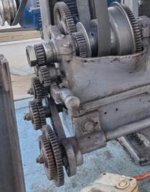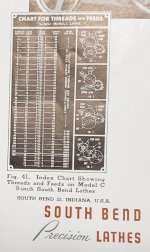Hey guys. I have a vintage Australian made bench top lathe, see photos from my other thread here: https://www.practicalmachinist.com/...vintage-benchtop-lathe-identification-393201/
I'm trying to get my head around the change gears. I was supplied 8 in total: 25, 30, 35, 40, 45, 50, 55, 60 and 63 teeth. I believe I'm missing at least 1 or 2, probably a small one or very big one. The reason I think that is I've created an excel spreadsheet and crunched the numbers, and unless I've completely stuffed up I cannot find any possible way to cut any thread finer than 21 TPI. I'm also missing a few TPI values that I thought would of been possible (10 TPI, 13 TPI, 16 TPI). I've calculated with and without back gear engaged, and I'm not even sure half of those gear arrangements would physically fit either.
Here's what I've worked out:
-Engaging the back gear makes the chuck turn at 0.16x the spindle RPM (28T driving a 70T - 2 times)
-Spindle RPM is maintained through the forward/reverse selector mechanism (its all 20T gears)
-The 25 tooth gear is currently on the output of the reverse mechanism. It's possible to change this gear but nothing bigger will physically fit, but a smaller gear would.
-The amount of sliding adjustment on the idler gear stud indicates there probably a much bigger gear missing.
-The leadscrew is 8 TPI
I know I'm missing gears, but what gears would I likely be missing? Is this a common set of gears?
Also, what gears would I need to cut metric threads? Is that at all possible with this lathe?
Cheers
I'm trying to get my head around the change gears. I was supplied 8 in total: 25, 30, 35, 40, 45, 50, 55, 60 and 63 teeth. I believe I'm missing at least 1 or 2, probably a small one or very big one. The reason I think that is I've created an excel spreadsheet and crunched the numbers, and unless I've completely stuffed up I cannot find any possible way to cut any thread finer than 21 TPI. I'm also missing a few TPI values that I thought would of been possible (10 TPI, 13 TPI, 16 TPI). I've calculated with and without back gear engaged, and I'm not even sure half of those gear arrangements would physically fit either.
Here's what I've worked out:
-Engaging the back gear makes the chuck turn at 0.16x the spindle RPM (28T driving a 70T - 2 times)
-Spindle RPM is maintained through the forward/reverse selector mechanism (its all 20T gears)
-The 25 tooth gear is currently on the output of the reverse mechanism. It's possible to change this gear but nothing bigger will physically fit, but a smaller gear would.
-The amount of sliding adjustment on the idler gear stud indicates there probably a much bigger gear missing.
-The leadscrew is 8 TPI
I know I'm missing gears, but what gears would I likely be missing? Is this a common set of gears?
Also, what gears would I need to cut metric threads? Is that at all possible with this lathe?
Cheers







